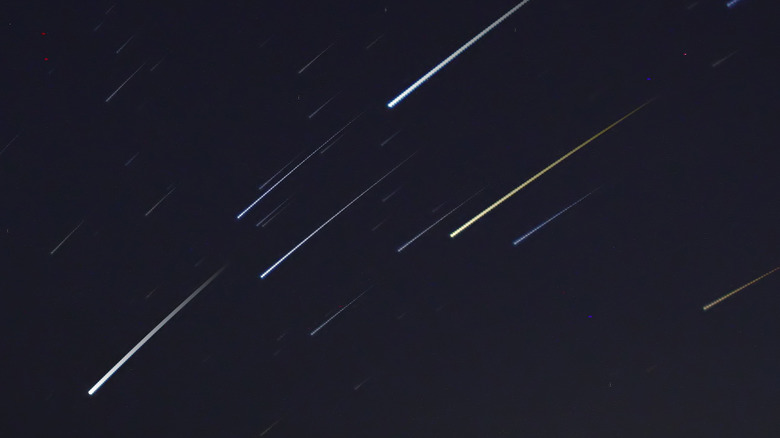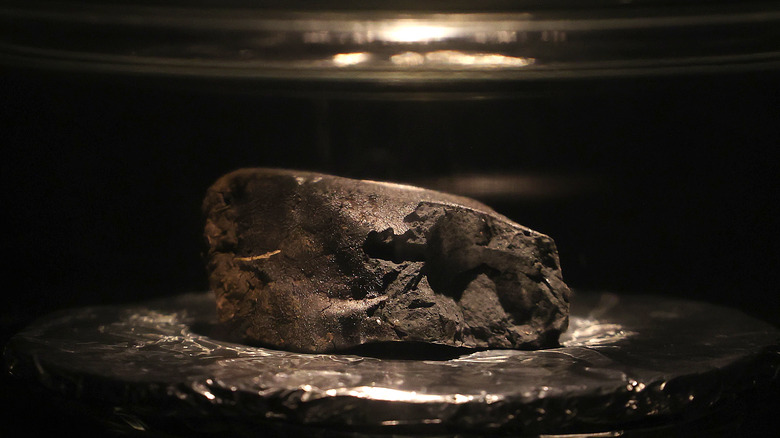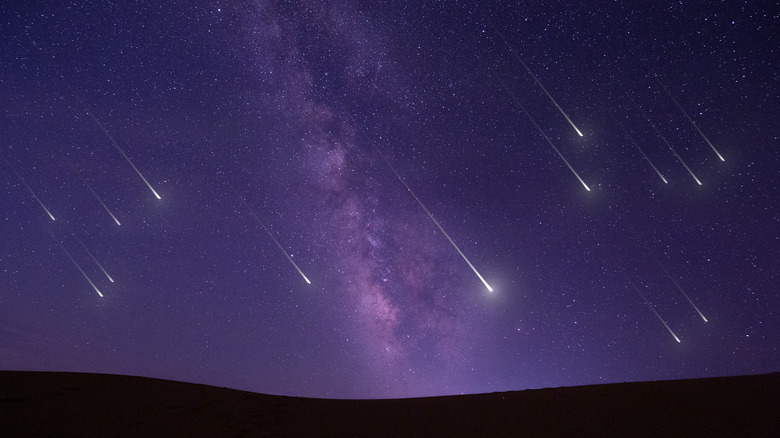A Startling Number Of Meteors Hit The Earth Every Day
As a kid, you might have been taught that if you wish upon a falling star, all your dreams will come true. It's a nice story for the little ones, but it's pretty inaccurate — not least because falling stars aren't stars at all. In fact, they're meteors, the term used for bits of space rock that burn up as they fall through the Earth's atmosphere (via NASA). Comprised of minerals and heavy metals (via National Geographic), these meteors are generally pretty small, weighing only a couple of grams each, so they don't pose much of a threat to life on Earth, per the American Meteor Society.
Still, that doesn't mean any given falling meteor is totally safe for Earth-dwellers. A number of large meteorite impacts have caused serious damage in the past — most notably a meteorite whose landing impact roughly 66 million years ago kickstarted a global mass extinction. (If you haven't guessed by now, it's the same one that killed off the dinosaurs, leaving a parting gift in the form of what scientists now call the Chicxulub crater, located in Mexico's Yucatan peninsula, per Astronomy magazine.) Considering that as a textbook example of meteors gone awry, NASA and other researchers study and monitor objects which might intersect with (and pose a threat to) life on Earth, according to the agency's Jet Propulsion Lab's website. Unsurprisingly, one of the key aspects of that research is figuring out just how many falling objects hit the Earth each day of the year.
Meteors and meteorites and asteroids, oh my!
Even though some people seem to use the words "meteor" and "meteorite" interchangeably — or might even mistake other space objects like asteroids and comets as more of the same — each and every one of them is in a unique category of its own. According to the National Informal STEM Education Network, asteroids are large rocky objects which orbit the sun that range much, much larger in size compared to your typical tinier meteoroids. When it comes to the idea of space rocks hitting the Earth's surface, it's asteroids you need to worry about most — but these kinds of events are by and large extremely rare. Similar to asteroids, comets, too, orbit the sun, but are made of ice instead of rock; while it's possible for a comet to also hit our planet, it's even rarer for this to happen than it would be for an asteroid.
As opposed to asteroids or comets, meteors and meteorites frequently hit our atmosphere, but their typically tiny size prevents them from doing any damage, if at all. Per NASA, this is why meteoroids as a whole tend to burn up during their descent through our planet's atmosphere — and whatever is left and manages to make it to the surface is what distinguishes it as a meteorite, rather than a meteor.
How many meteorites hit the Earth each day?
The exact number of meteorites that hit the Earth each day isn't known exactly known. Meteorites can be hard to track, in part because of their small size, and in part due to the fact that meteorites can land in any number of random places — including places like deserts and oceans that are uninhabitable for humans. Unsurprisingly, this makes meteorites extremely difficult to recover.
Various research studies have attempted to estimate the number of meteors that hit the Earth's atmosphere each year. One such study, published in 2019, estimated that around 17 meteorites hit the Earth's surface each day — making that a grand total of more than 6,000 a year (via Cosmos). The study also noted that the vast majority of those impacts go unseen. Other estimates have been more conservative, like that approximately 500 meteorites make landfall yearly, averaging at a little over one meteorite per day. Even still, some researchers suggest the number is far higher; one study published by the scientific journal Geology in 2020 guessed the number of meteorite impacts per year is as high as 17,000, or 47 per day (via Iberdrola). Still, while the exact number isn't known, one thing is clear: Whatever the real number is, it's certainly a lot more frequent than spotting the odd, errant shooting star.


